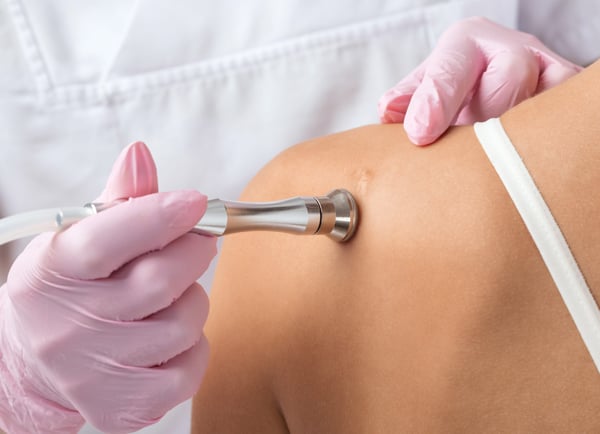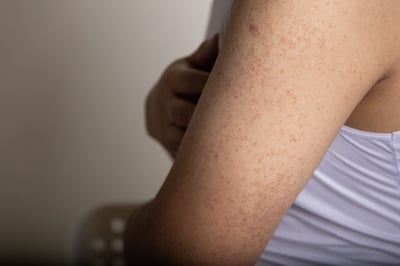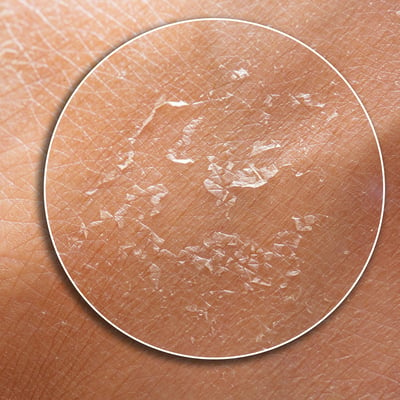
After receiving a skin cancer diagnosis, seeking the most effective treatment is certainly the top priority. However, sometimes skin cancer removal leaves patients with scarring or indentations that change their appearance. Even after being relieved that the cancer is gone, it’s not uncommon to feel self-conscious and unhappy about these changes.
If you have recently undergone skin cancer surgery, the good news is that there are several treatments available to minimize scarring and restore your look. While reconstructive surgery is an option, there are less invasive procedures that might be suitable for you. Your doctor will discuss the best treatment for your particular case.
Why do scars form after skin cancer treatment?
Often, eliminating skin cancer involves removing multiple layers of skin, which can lead to scarring. Mohs surgery, the most effective treatment for basal cell and squamous cell carcinoma, involves surgically removing skin cancer layers until healthy, cancer-free tissue remains. This might leave indentations in the skin where the tumor was. As the body heals, skin grows back quickly. Instead of getting neatly stacked cells and collagen as in normal skin growth, cells and collagen pile up…resulting in thick scars and an uneven texture. Since Mohs surgery is often performed on visible areas like the nose, eyelids, lips, ears, hands, and feet, it can significantly change a patient’s appearance.
For advanced melanoma, surgery might involve deeper excisions or lymph node removal—both of which can result in scarring.
To minimize scarring, skin cancer surgeons provide instructions to keep the wound clean and dry, avoid direct sunlight, and wear sunscreen. They also recommend using topical treatments such as silicone gel or sheets to reduce redness and inflammation. Despite these efforts, scarring and uneven skin texture can still happen.
Tired of surgeries? These non-invasive solutions can restore your look
While revision surgery can minimize the visibility and size of a scar after skin cancer treatment, it is invasive. Often, surgical scar treatment involves removing excess tissue from around a scar and/or adding tissue or fat from another area of the body. Recovery can range from weeks to months. If you are looking for a less invasive option and a quicker recovery time, ask your doctor about one of these options:
CO2 laser therapy
This advanced laser treatment is often used after Mohs surgery. It targets damaged skin cells, stimulating collagen production and smoothing out irregularities. The laser creates microscopic tunnels in the scar tissue that are replaced with regular tissue, so that the dense scar tissue gives way to more normal skin. The total course of therapy can take 3-12 monthly visits, depending on the severity of scarring and the patient’s aesthetic goals.
Intense pulsed light, or IPL
Although not a true laser, IPL uses light to target two substances that affect a scar’s appearance: hemoglobin, found in blood vessels and red blood cells makes scar tissue look red; and melanin, which gives skin cells color and can create darkened scars. Using IPL destroys hemoglobin and melanin in scars to fade the tissue so it blends better with the surrounding skin.
Dermabrasion
Dermabrasion involves a doctor using a handheld rotating wheel or brush to gently “sand” the outer layers of scars. This creates a smoother, naturally looking skin surface so scars are less noticeable. There are several methods and devices used to perform dermabrasion, including crystal dermabrasion for delicate areas like the face and nose; and the more aggressive diamond dermabrasion, which is better for the legs, arms, and back.
Chemical peels
Chemical peels work similarly to dermabrasion, but use chemical solutions to remove the outermost skin cells on top of the scar. As new, smoother skin grows in, the scar looks more like the natural skin cells around it. Chemical peels usually work best for mild scars.
Microneedling
Also referred to as “collagen production therapy,” microneedling creates tiny punctures in the skin, which stimulates the growth of new skin. As the body heals the tiny holes in the skin with just the right amount of collagen, scars become more even-toned and less noticeable. However, it’s important to note that while at-home microneedling kits are available, they can be risky and don’t deliver the results achieved by a dermatologist. Additional scarring and infection are possible, and changes in skin color and texture can make scars even more noticeable.
Dermal fillers
Depressed, sunken areas are common after skin cancer treatment, particularly if the removed tumor was deep or wide. Dermal fillers are effective at restoring volume in these areas so they are even with surrounding tissue. Doctors use a tiny needle to inject hyaluronic acid under and around the scar, with almost immediate results.
Now that you’ve completed skin cancer treatment, it’s time to love who you see in the mirror
Completing skin cancer treatment is a huge step—one that deserves celebration. If you’re unhappy with the scars left from your surgery, talk to a Forefront provider about the best option for you. Together we will find the solution that meets your aesthetic goals and helps you feel like yourself again.
Contact us today. We can’t wait to see your smile.





